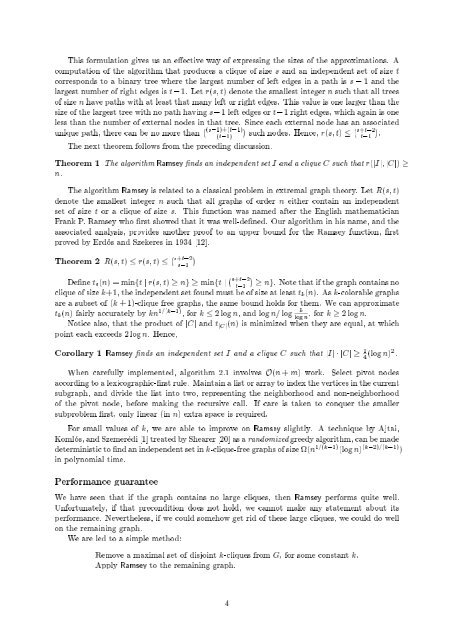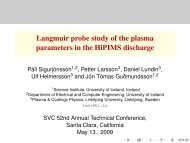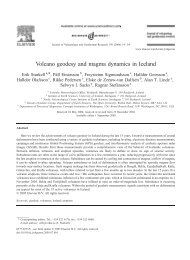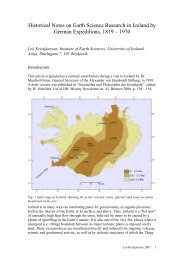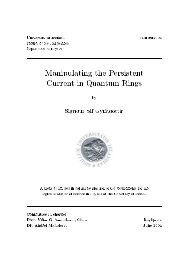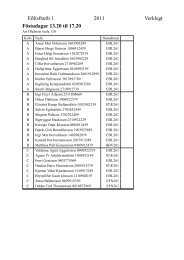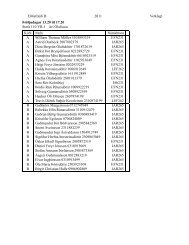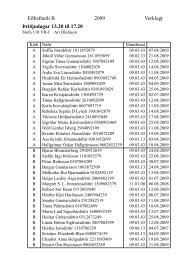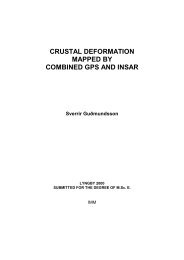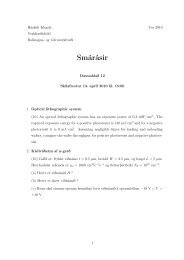Approximating Maximum Independent Sets by Excluding Subgraphs 1
Approximating Maximum Independent Sets by Excluding Subgraphs 1
Approximating Maximum Independent Sets by Excluding Subgraphs 1
Create successful ePaper yourself
Turn your PDF publications into a flip-book with our unique Google optimized e-Paper software.
This formulation gives us an eective way of expressing the sizes of the approximations. Acomputation of the algorithm that produces a clique of size s and an independent set of size tcorresponds to a binary tree where the largest number of left edges in a path is s 0 1 and thelargest number of right edges is t 0 1. Let r(s; t) denote the smallest integer n such that all treesof size n have paths with at least that many left or right edges. This value is one larger than thesize of the largest tree with no path having s01 left edges or t01 right edges, which again is oneless than the number of external nodes in that tree. Since each external node has an associatedunique path, there can be no more than 0 (s01)+(t01)1 0(t01) such nodes. Hence, r(s; t) s+t021t01 .The next theorem follows from the preceding discussion.Theorem 1 The algorithm Ramsey nds an independent set I and a clique C such that r(jIj; jCj) n.The algorithm Ramsey is related to a classical problem in extremal graph theory. Let R(s; t)denote the smallest integer n such that all graphs of order n either contain an independentset of size t or a clique of size s. This function was named after the English mathematicianFrank P. Ramsey who rst showed that it was well-dened. Our algorithm in his name, and theassociated analysis, provides another proof to an upper bound for the Ramsey function, rstproved <strong>by</strong> Erd}os and Szekeres in 1934 [12].Theorem 2 R(s; t) r(s; t) 0 1s+t02s01Dene t s (n) = minft j r(s; t) ng minft j 0 1s+t02t01 ng. Note that if the graph contains noclique of size k+1, the independent set found must be of size at least t k (n). As k-colorable graphsare a subset of (k + 1)-clique free graphs, the same bound holds for them. We can approximatet k (n) fairly accurately <strong>by</strong> kn 1=(k01) , for k 2 log n, and log n= log , for k 2 log n.Notice also, that the product of jCj and t jCj (n) is minimized when they are equal, at whichpoint each exceeds 2 log n. Hence,Corollary 1 Ramsey nds an independent set I and a clique C such that jIj 1 jCj 1 4 (log n)2 .When carefully implemented, algorithm 2.1 involves O(n + m) work. Select pivot nodesaccording to a lexicographic-rst rule. Maintain a list or array to index the vertices in the currentsubgraph, and divide the list into two, representing the neighborhood and non-neighborhoodof the pivot node, before making the recursive call. If care is taken to conquer the smallersubproblem rst, only linear (in n) extra space is required.For small values of k, we are able to improve on Ramsey slightly. A technique <strong>by</strong> Ajtai,Komlos, and Szemeredi [1] treated <strong>by</strong> Shearer [20] as a randomized greedy algorithm, can be madedeterministic to nd an independent set in k-clique-free graphs of size (n 1=(k01) (log n) (k02)=(k01) )in polynomial time.Performance guaranteeWe have seen that if the graph contains no large cliques, then Ramsey performs quite well.Unfortunately, if that precondition does not hold, we cannot make any statement about itsperformance. Nevertheless, if we could somehow get rid of these large cliques, we could do wellon the remaining graph.We are led to a simple method:klog nRemove a maximal set of disjoint k-cliques from G, for some constant k.Apply Ramsey to the remaining graph.4


